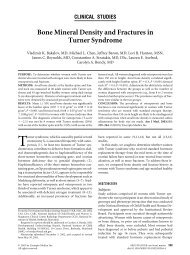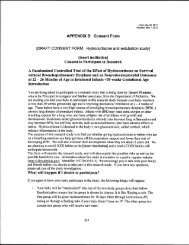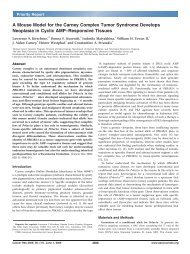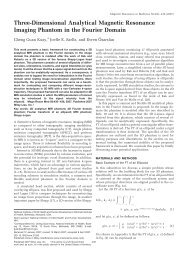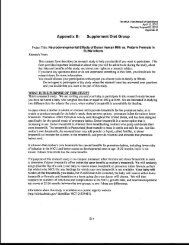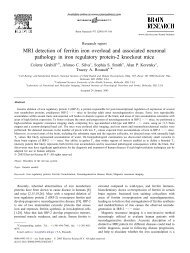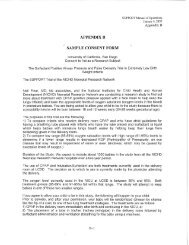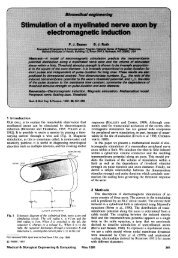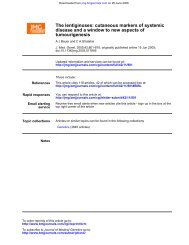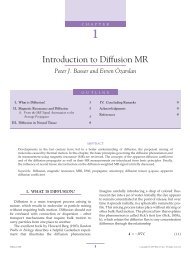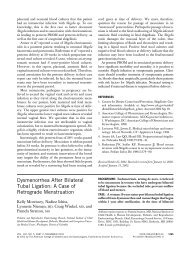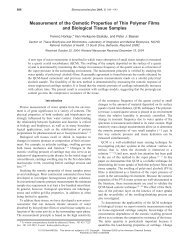Osmotic Swelling of Polyacrylate Hydrogels in Physiological Salt ...
Osmotic Swelling of Polyacrylate Hydrogels in Physiological Salt ...
Osmotic Swelling of Polyacrylate Hydrogels in Physiological Salt ...
You also want an ePaper? Increase the reach of your titles
YUMPU automatically turns print PDFs into web optimized ePapers that Google loves.
84 Biomacromolecules 2000, 1, 84-90<br />
<strong>Osmotic</strong> <strong>Swell<strong>in</strong>g</strong> <strong>of</strong> <strong>Polyacrylate</strong> <strong>Hydrogels</strong> <strong>in</strong> <strong>Physiological</strong><br />
<strong>Salt</strong> Solutions<br />
Ferenc Horkay,* Ichiji Tasaki, and Peter J. Basser<br />
Section on Tissue Biophysics and Biomimetics, NICHD, National Institutes <strong>of</strong> Health, 13 South Drive,<br />
Bethesda, Maryland 20892-5772<br />
Received November 8, 1999<br />
The swell<strong>in</strong>g behavior <strong>of</strong> fully neutralized sodium polyacrylate gels was <strong>in</strong>vestigated <strong>in</strong> aqueous solutions<br />
<strong>of</strong> alkali metal (LiCl, NaCl, KCl, CsCl) and alkal<strong>in</strong>e earth metal salts (CaCl 2 , SrCl 2 , BaCl 2 ). The total salt<br />
concentration and the ratio <strong>of</strong> monovalent to divalent cations were varied <strong>in</strong> the biologically significant<br />
range. It is found that the concentrations <strong>of</strong> both monovalent and divalent cations vary cont<strong>in</strong>uously and<br />
smoothly <strong>in</strong> the gel despite the abrupt change <strong>in</strong> the gel volume. The <strong>in</strong>dividual elastic, mix<strong>in</strong>g, and ionic<br />
contributions to the free energy <strong>of</strong> the gel were separately determ<strong>in</strong>ed as a function <strong>of</strong> the degree <strong>of</strong> network<br />
swell<strong>in</strong>g to elucidate the thermodynamics <strong>of</strong> swell<strong>in</strong>g. Shear modulus measurements performed at different<br />
Ca 2+ concentrations suggest that Ca 2+ does not form stable cross-l<strong>in</strong>ks between the polymer cha<strong>in</strong>s. At low<br />
and moderate swell<strong>in</strong>g ratios the concentration dependence <strong>of</strong> the shear modulus follows a power law behavior,<br />
G ∝ φ n , with n ) 0.34 ( 0.03. At high swell<strong>in</strong>g degrees, however, the shear modulus <strong>in</strong>creases with <strong>in</strong>creas<strong>in</strong>g<br />
swell<strong>in</strong>g. The value <strong>of</strong> the Flory-Hugg<strong>in</strong>s <strong>in</strong>teraction parameter, χ, determ<strong>in</strong>ed from osmotic swell<strong>in</strong>g pressure<br />
and shear modulus measurements, strongly depends on the ionic composition <strong>of</strong> the equilibrium solution<br />
and <strong>in</strong>creases with <strong>in</strong>creas<strong>in</strong>g Ca 2+ concentration.<br />
Introduction<br />
The phenomenon <strong>of</strong> gel swell<strong>in</strong>g has been the subject <strong>of</strong><br />
numerous studies 1-10 <strong>in</strong> polymer physics. It has been<br />
demonstrated that m<strong>in</strong>ute changes <strong>in</strong> external conditions such<br />
as <strong>in</strong> temperature, 5 solvent composition, 8 ionic strength, 7,9<br />
and external electric field, 6 can <strong>in</strong>duce drastic changes <strong>in</strong><br />
the state <strong>of</strong> the swollen network. In particular, it is wellknown<br />
that under certa<strong>in</strong> conditions, polyelectrolyte gels may<br />
undergo a discont<strong>in</strong>uous volume change. 5 It was found that<br />
as a result <strong>of</strong> coupl<strong>in</strong>g between ionization degree and<br />
elasticity these systems exhibit a variety <strong>of</strong> <strong>in</strong>terest<strong>in</strong>g<br />
mechanical and scatter<strong>in</strong>g properties. 13-17<br />
These previous studies on polyelectrolyte gels do not<br />
address explicitly the thermodynamic conditions (i.e., pH,<br />
ionic strentgth, ionic composition, etc.) that are likely to occur<br />
<strong>in</strong> biological systems. However, recent studies unambiguously<br />
<strong>in</strong>dicate 18-20 that swell<strong>in</strong>g occurs <strong>in</strong> many physiological<br />
systems and plays a crucial role <strong>in</strong> physiological processes<br />
such as nerve excitation, muscle contraction, and cell<br />
locomotion. View<strong>in</strong>g nerve excitation from a physicochemical<br />
standpo<strong>in</strong>t, Tasaki 18-22 has shown that synthetic polyanionic<br />
gels (e.g., poly(methacrylic acid) gels, poly(acrylic<br />
acid) gels) can exhibit discont<strong>in</strong>uous volume changes by<br />
us<strong>in</strong>g a biologically plausible mechanism <strong>of</strong> monovalentdivalent<br />
cation exchange.<br />
These biomimetic studies raise several important questions:<br />
What are the specific thermodynamic factors govern<strong>in</strong>g<br />
the swell<strong>in</strong>g and deswell<strong>in</strong>g behavior <strong>of</strong> anionic gels<br />
* To whom correspondence may be addressed. E-mail: horkay@<br />
helix.nih.gov.<br />
dur<strong>in</strong>g monovalent-divalent ion exchange Prior to and<br />
follow<strong>in</strong>g an equilibrium phase transition, how are the mobile<br />
cations and water molecules redistributed between the<br />
external bath and the gel phase How do the mobile cations<br />
<strong>in</strong>teract with the charged polymer cha<strong>in</strong>s How reversible<br />
is the ion-exchange process<br />
To address these questions systematic thermodynamic and<br />
mechanical measurements were carried out on sodium<br />
polyacrylate gels immersed <strong>in</strong> solutions conta<strong>in</strong><strong>in</strong>g the salts<br />
<strong>of</strong> alkali metal (Li + ,Na + ,K + ,Cs + ) and alkal<strong>in</strong>e earth metal<br />
cations (Ca 2+ ,Sr 2+ ,Ba 2+ ) <strong>in</strong> which the total salt concentration<br />
and the ratio <strong>of</strong> monovalent to divalent cations were varied<br />
<strong>in</strong> the biologically significant range. An attempt was made<br />
to separate the elastic, mix<strong>in</strong>g and ionic contributions <strong>of</strong> the<br />
total free energy <strong>of</strong> the gel. New experimental results<br />
obta<strong>in</strong>ed by <strong>in</strong>dependently and successively vary<strong>in</strong>g the salt<br />
concentration, the ionic composition, and the chemical<br />
potential <strong>of</strong> water are presented. The swell<strong>in</strong>g pressure, the<br />
elastic modulus, and the equilibrium volume fraction <strong>of</strong> the<br />
gels were measured under different conditions, while the ion<br />
concentrations and the molar ratio <strong>of</strong> monovalent to divalent<br />
cations were kept <strong>in</strong> the normal physiological range.<br />
Theory<br />
<strong>Swell<strong>in</strong>g</strong> equilibrium is atta<strong>in</strong>ed when the total change <strong>in</strong><br />
the free energy, ∆F tot , reaches a m<strong>in</strong>imum or, equivalently,<br />
when the chemical potentials <strong>of</strong> all mobile components <strong>in</strong><br />
the coexist<strong>in</strong>g phases are the same.<br />
In the case <strong>of</strong> nonionic networks 1,23,24 swollen <strong>in</strong> a onecomponent<br />
liquid, ∆F tot is simply the sum <strong>of</strong> the free energy<br />
10.1021/bm9905031 This article not subject to U.S. Copyright. Published 2000 by the American Chemical Society<br />
Published on Web 02/04/2000
Gel <strong>Swell<strong>in</strong>g</strong> <strong>in</strong> <strong>Physiological</strong> <strong>Salt</strong> Solutions Biomacromolecules, Vol. 1, No. 1, 2000 85<br />
<strong>of</strong> elastic deformation <strong>of</strong> the network, ∆F el , and the free<br />
energy <strong>of</strong> mix<strong>in</strong>g <strong>of</strong> the network cha<strong>in</strong>s and solvent<br />
molecules, ∆F mix . In the case <strong>of</strong> polyelectrolyte systems there<br />
is an additional term due to the presence <strong>of</strong> the counterions,<br />
∆F ion . Assum<strong>in</strong>g that these terms are <strong>in</strong>dependent, we can<br />
write 1<br />
∆F tot ) ∆F el + ∆F mix + ∆F ion (1)<br />
In an osmotic swell<strong>in</strong>g experiment the measurable quantities<br />
<strong>in</strong>volve derivatives <strong>of</strong> the free energy, i.e.,<br />
Π tot )-V 1 -1 (∂∆F tot /∂n 1 ) ) Π el + Π mix + Π ion (2)<br />
where Π tot is the swell<strong>in</strong>g pressure <strong>of</strong> the gel, Π el , Π mix , and<br />
Π ion are the elastic, mix<strong>in</strong>g, and ionic contributions <strong>of</strong> Π tot ,<br />
respectively, V 1 is the molar volume <strong>of</strong> the solvent, and n 1<br />
is the number <strong>of</strong> moles <strong>of</strong> solvent.<br />
For networks made <strong>of</strong> flexible cha<strong>in</strong>s the elastic pressure,<br />
Π el , is obta<strong>in</strong>ed from the theory <strong>of</strong> rubber elasticity 1,25<br />
Π el )-ARTνφ 1/3 )-G (3)<br />
where ν is the concentration <strong>of</strong> the elastic cha<strong>in</strong>s, φ is the<br />
volume fraction <strong>of</strong> the polymer, R is the gas constant, and T<br />
is the absolute temperature. The prefactor, A, depends on<br />
the functionality <strong>of</strong> the junctions. Π el can be identified with<br />
the shear modulus, G, <strong>of</strong> the gel.<br />
It was po<strong>in</strong>ted out by several authors that f<strong>in</strong>ite extensibility<br />
<strong>of</strong> the network cha<strong>in</strong>s plays a significant role <strong>in</strong> highly<br />
swollen polyelectrolyte gels. Then, the elastic pressure term<br />
can be described more realistically by theories based on non-<br />
Gaussian cha<strong>in</strong> statistics. 15,23,24<br />
The osmotic pressure, Π mix , due to the mix<strong>in</strong>g <strong>of</strong> network<br />
cha<strong>in</strong>s and solvent molecules can be expressed by the Flory-<br />
Hugg<strong>in</strong>s equation<br />
Π mix )- RT<br />
V 1<br />
[ln(1 - φ) + (1 - P -1 )φ + χφ 2 ] (4)<br />
where P is the degree <strong>of</strong> polymerization and χ is the Flory-<br />
Hugg<strong>in</strong>s <strong>in</strong>teraction parameter. For a cross-l<strong>in</strong>ked polymer<br />
P ) ∞. Usually χ depends on polymer concentration, i.e., χ<br />
) χ 0 + χ 1 φ + ...<br />
In general, <strong>in</strong> polyelectrolyte gels there is a difference <strong>in</strong><br />
mobile ion concentrations <strong>in</strong>side and outside the gel. This<br />
difference is caused by the requirement to satisfy the<br />
electroneutrality condition. 1 This results <strong>in</strong> an osmotic<br />
pressure difference between the gel and the equilibrium<br />
solution. A complete description <strong>of</strong> the effect <strong>of</strong> ions would<br />
also require to account for contributions due to mix<strong>in</strong>g <strong>of</strong><br />
ions with solvent molecules and <strong>in</strong>teractions between ions,<br />
polymer segments, and solvent molecules. 27 Here we only<br />
consider the first contribution given by the Donnan theory<br />
N<br />
Π ion ) RT ∑ (c gel j - c sol j ) (5)<br />
j)1<br />
where c j<br />
gel<br />
and c j<br />
sol<br />
represent the concentrations <strong>of</strong> the ions<br />
<strong>in</strong> the gel and the equilibrium solution, respectively, and N<br />
is the number <strong>of</strong> mobile ions <strong>in</strong> the system.<br />
In the case <strong>of</strong> a 1-1 electrolyte (e.g., NaCl) we have<br />
c +gel Na c -gel Cl ) c +sol sol<br />
Na c Cl -<br />
If the external solution can be assumed to be <strong>in</strong>f<strong>in</strong>ite <strong>in</strong><br />
extent, we may write<br />
S<strong>in</strong>ce both Na + and Cl - ions diffuse <strong>in</strong>to the gel <strong>in</strong> the<br />
case <strong>of</strong> an anionic polyelectrolyte gel (e.g., sodium polyacrylate),<br />
we have<br />
where i is the degree <strong>of</strong> ionization and V m is the molar<br />
volume <strong>of</strong> the monomer unit <strong>of</strong> the polymer.<br />
Accord<strong>in</strong>g to eq 8 the total amount <strong>of</strong> Na + <strong>in</strong> the gel equals<br />
the sum <strong>of</strong> Cl - that moved <strong>in</strong>to the gel and the amount <strong>of</strong><br />
Na + ions needed to neutralize the charged groups (iφ/V m ).<br />
Comb<strong>in</strong><strong>in</strong>g eqs 6, 7, and 8 we get<br />
It should be noted that only the mobile ions contribute to<br />
the swell<strong>in</strong>g pressure, and eq 9 is valid if the activity<br />
coefficient <strong>of</strong> the mobile ions is the same <strong>in</strong> the gel and <strong>in</strong><br />
the equilibrium solution.<br />
Polyelectrolye behavior is governed by the ratio <strong>of</strong> the<br />
electrostatic energy between two neighbor<strong>in</strong>g charges on the<br />
cha<strong>in</strong> to the thermal energy. As the density <strong>of</strong> charges on<br />
the polymer molecules is <strong>in</strong>creased, the relative importance<br />
<strong>of</strong> short-range attractive (van der Waals) <strong>in</strong>teractions and<br />
long-range repulsive electrostatic <strong>in</strong>teractions changes. The<br />
relevant characteristic length scale is def<strong>in</strong>ed by the Bjerrum<br />
length<br />
where e is the electron charge, ɛ is the permittivity <strong>of</strong> water,<br />
and k is the Boltzmann constant. (At λ ) 1, attractive to<br />
repulsive <strong>in</strong>teractions are equal.) When the distance, d,<br />
between neighbor<strong>in</strong>g charges is much larger than the Bjerrum<br />
length (d/λ . 1), counterions are uniformly distributed<br />
throughout the gel. Consequently, swell<strong>in</strong>g is driven by their<br />
osmotic pressure. When (d/λ < 1), counterions are closely<br />
bound to the cha<strong>in</strong>s (counterion condensation).<br />
Theoretical models 28-30 predict that counterions are bound<br />
to the polyelectrolyte cha<strong>in</strong> when the charge density exceeds<br />
a critical threshold value, R, which can be estimated us<strong>in</strong>g<br />
the equation<br />
where d (distance between neighbor<strong>in</strong>g charges) is equal to<br />
the monomer length, i.e., 2.5 Å, and λ ) 7 Å <strong>in</strong> water at 25<br />
°C. This yields R)0.36.<br />
Experimental Design<br />
Here we summarize the strategy followed to accomplish<br />
the pr<strong>in</strong>cipal objective <strong>of</strong> the present study, i.e., further<br />
(6)<br />
c Na +sol ) c Cl -sol ) c sol (7)<br />
c Na +gel ) c Cl -gel + iφ/V m (8)<br />
Π ion ) 2RT{[(c sol ) 2 + (iφ/(2V m )) 2 ] 1/2 - c sol } (9)<br />
λ ) e 2 /ɛkT (10)<br />
R)d/λ (11)
86 Biomacromolecules, Vol. 1, No. 1, 2000 Horkay et al.<br />
understand<strong>in</strong>g the macroscopic swell<strong>in</strong>g behavior <strong>of</strong> polyacrylate<br />
networks immersed <strong>in</strong> solutions conta<strong>in</strong><strong>in</strong>g both<br />
monovalent and divalent cations <strong>in</strong> a physiological concentration<br />
range.<br />
1. One <strong>of</strong> the basic assumptions <strong>in</strong> the theoretical treatment<br />
<strong>of</strong> gel swell<strong>in</strong>g is that the effect <strong>of</strong> low molecular weight<br />
salts on the swell<strong>in</strong>g pressure can be treated as an additive<br />
term <strong>in</strong> eq 2. To separate the ionic component from the total<br />
swell<strong>in</strong>g pressure, two <strong>in</strong>dependent sets <strong>of</strong> experiments were<br />
performed: (i) measurements <strong>of</strong> the equilibrium swell<strong>in</strong>g<br />
degree <strong>in</strong> salt solutions as a function <strong>of</strong> the salt concentration;<br />
(ii) measurements <strong>of</strong> the swell<strong>in</strong>g degree <strong>in</strong> equilibrium with<br />
water as a function <strong>of</strong> the water activity.<br />
2. Understand<strong>in</strong>g the thermodynamics <strong>of</strong> gel swell<strong>in</strong>g,<br />
particularly the role <strong>of</strong> different counterions, requires knowledge<br />
<strong>of</strong> the concentration <strong>of</strong> all mobile components <strong>in</strong>side<br />
the gel and <strong>in</strong> the equilibrium solution. Therefore, measurements<br />
were made not only <strong>of</strong> the equilibrium swell<strong>in</strong>g degree<br />
<strong>of</strong> the gels but also <strong>of</strong> the concentrations <strong>of</strong> the relevant ions.<br />
3. To obta<strong>in</strong> quantitative <strong>in</strong>formation on the effect <strong>of</strong><br />
counterions on the elastic response <strong>of</strong> the gels, shear modulus<br />
measurements were performed at different ion concentrations.<br />
4. Assum<strong>in</strong>g the additivity <strong>of</strong> terms <strong>in</strong> eq 2, the mix<strong>in</strong>g<br />
pressure <strong>of</strong> the gel and, hence, the variation <strong>of</strong> the Flory-<br />
Hugg<strong>in</strong>s <strong>in</strong>teraction parameter with the ionic composition<br />
<strong>of</strong> the solution were determ<strong>in</strong>ed.<br />
Experimental Methods<br />
Gel Preparation. Poly(acrylic acid) gels were synthesized<br />
by free-radical copolymerization <strong>of</strong> partially neutralized<br />
acrylic acid and N,N′-methylenebis(acrylamide) <strong>in</strong> aqueous<br />
solution follow<strong>in</strong>g the procedure described by Sugitani et<br />
al. 31 Special molds were used to make cyl<strong>in</strong>drical (1 cm<br />
height, 1 cm diameter) gels. The monomer concentration was<br />
30% (w/w). In the <strong>in</strong>itial mixture 35% <strong>of</strong> the monomers were<br />
neutralized by sodium hydroxide. After the components were<br />
mixed, dissolved oxygen that would <strong>in</strong>hibit the polymerization<br />
reaction was elim<strong>in</strong>ated by bubbl<strong>in</strong>g nitrogen through<br />
the solution. The polymerization reaction was <strong>in</strong>itiated by<br />
ammonium persulfate (0.5 g/L). Gelation was achieved at<br />
80 °C. Gels were kept at 80 °C for 2 h and then were allowed<br />
to set at room temperature for 20 h to ensure that the reaction<br />
was complete. Gel cyl<strong>in</strong>ders were removed from the mold,<br />
neutralized fully, and placed <strong>in</strong> deionized water to remove<br />
any unreacted materials and other components (sol fraction,<br />
excess ions) not attached to the network. Water was replaced<br />
every day for 2 weeks. The swell<strong>in</strong>g equilibrium concentration<br />
<strong>of</strong> the gels was determ<strong>in</strong>ed <strong>in</strong> pure deionized water and<br />
<strong>in</strong> solutions <strong>of</strong> different salts.<br />
Gel beads were made by polymerization <strong>in</strong> silicone oil<br />
(viscosity, 1000 cP s), that was previously degassed with<br />
nitrogen. Spherical droplets (
Gel <strong>Swell<strong>in</strong>g</strong> <strong>in</strong> <strong>Physiological</strong> <strong>Salt</strong> Solutions Biomacromolecules, Vol. 1, No. 1, 2000 87<br />
Figure 1. Variation <strong>of</strong> the equilibrium swell<strong>in</strong>g degree (1/φ) <strong>of</strong> sodium<br />
polyacrylate gel as a function <strong>of</strong> the salt concentration <strong>in</strong> solutions <strong>of</strong><br />
1:1 salts: ], LiCl; O, NaCl; 4, KCl; ×, CsCl.<br />
Figure 2. <strong>Swell<strong>in</strong>g</strong> pressure calculated by eq 9 from the measured<br />
equilibrium concentrations <strong>of</strong> the polymer and salt, plotted aga<strong>in</strong>st<br />
swell<strong>in</strong>g pressure obta<strong>in</strong>ed from direct osmotic deswell<strong>in</strong>g experiments<br />
performed on salt-free gels.<br />
nature <strong>of</strong> the cations. This dependence follows the H<strong>of</strong>fmeister<br />
series (lyotropic series); i.e., the observed deswell<strong>in</strong>g<br />
effect <strong>in</strong>creases with decreas<strong>in</strong>g ionic radius Li < Na < K<br />
< Cs.<br />
In Figure 2 the pressure contribution, Π ion , due to the<br />
concentration difference <strong>of</strong> small ions between the gel and<br />
the external solution calculated by eq 9 from data displayed<br />
<strong>in</strong> Figure 1, is plotted aga<strong>in</strong>st Π tot obta<strong>in</strong>ed from direct<br />
osmotic deswell<strong>in</strong>g measurements performed on salt-free<br />
gels. (In the latter experiment deswell<strong>in</strong>g was <strong>in</strong>duced by<br />
dissolv<strong>in</strong>g the neutral polymer <strong>in</strong> the equilibrium liquid<br />
phase.) The values at low swell<strong>in</strong>g pressures (Π < 100 kPa)<br />
are scattered around a theoretical straight l<strong>in</strong>e <strong>of</strong> slope unity<br />
demonstrat<strong>in</strong>g the equivalence <strong>of</strong> the response <strong>of</strong> the network<br />
Figure 3. Variation <strong>of</strong> the equilibrium swell<strong>in</strong>g degree (1/φ) <strong>of</strong> sodium<br />
polyacrylate gel as a function <strong>of</strong> the salt concentration <strong>in</strong> solutions <strong>of</strong><br />
2:1 salts: 4, CaCl 2; 3, SrCl 2; O, BaCl 2 (filled circles, NaCl).<br />
<strong>in</strong> the two experiments. This f<strong>in</strong>d<strong>in</strong>g implies that there are<br />
no specific <strong>in</strong>teractions between the polymer matrix and the<br />
monovalent salt ions. At higher values <strong>of</strong> Π ion (i.e., at lower<br />
swell<strong>in</strong>g ratios), however, the total swell<strong>in</strong>g pressure slightly<br />
exceeds that calculated on the basis <strong>of</strong> the Donnan theory.<br />
This is not surpris<strong>in</strong>g s<strong>in</strong>ce this theory fails to account for<br />
factors, such as electrostatic <strong>in</strong>teractions between the charged<br />
groups on the cha<strong>in</strong>s, and ion-ion <strong>in</strong>teractions between the<br />
salt and the charged network. When a gel consist<strong>in</strong>g <strong>of</strong><br />
ionized polymer cha<strong>in</strong>s is deswollen, the charge density<br />
<strong>in</strong>creases, thus generat<strong>in</strong>g electrostatic (Coulombic) <strong>in</strong>teractions.<br />
Several theories have been proposed to calculate the<br />
various electrostatic contributions for the total swell<strong>in</strong>g<br />
pressure. 27,34,35 S<strong>in</strong>ce, <strong>in</strong> the present system, the deviation<br />
from the Donnan theory is small, no attempt has been made<br />
to analyze the electrostatic effect quantitatively.<br />
Figure 3 presents the swell<strong>in</strong>g data <strong>of</strong> sodium polyacrylate<br />
gels <strong>in</strong> solutions <strong>of</strong> 2-1 salts (CaCl 2 , SrCl 2 , BaCl 2 ,). It can<br />
be seen that the swell<strong>in</strong>g degree is reduced much faster <strong>in</strong><br />
these solutions than <strong>in</strong> the solutions <strong>of</strong> monovalent cations.<br />
Qualitatively, this observation is consistent with expectations:<br />
add<strong>in</strong>g one divalent cation to the gel requires the<br />
exchange (or removal) <strong>of</strong> two monovalent cations <strong>in</strong> order<br />
to preserve electroneutrality.<br />
Figure 4a shows the variation <strong>of</strong> the swell<strong>in</strong>g degree <strong>of</strong> a<br />
gel <strong>in</strong> a solution conta<strong>in</strong><strong>in</strong>g both Na + and Ca 2+ ions. The<br />
addition <strong>of</strong> Ca 2+ ions decreases the degree <strong>of</strong> swell<strong>in</strong>g as<br />
expected. Above a certa<strong>in</strong> Ca 2+ concentration (<strong>in</strong> the range<br />
<strong>of</strong> 1-1.2 mM) the swell<strong>in</strong>g degree drastically decreases. In<br />
the figure are displayed the swell<strong>in</strong>g data determ<strong>in</strong>ed not<br />
only by <strong>in</strong>creas<strong>in</strong>g the salt concentration but also by<br />
decreas<strong>in</strong>g it. The fact that all data po<strong>in</strong>ts fall on the same<br />
curve <strong>in</strong>dicates the reversibility <strong>of</strong> the swell<strong>in</strong>g process.<br />
Figure 4b shows the variation <strong>of</strong> the Ca 2+ and Na + content<br />
<strong>in</strong>side the gel measured by us<strong>in</strong>g plasma optical emission<br />
and flame atomic absorption techniques. 36 It is apparent that<br />
the amount <strong>of</strong> both ions varies smoothly and cont<strong>in</strong>uously<br />
with<strong>in</strong> the gel despite the discont<strong>in</strong>uous change <strong>in</strong> the gel
88 Biomacromolecules, Vol. 1, No. 1, 2000 Horkay et al.<br />
Figure 5. Dependence <strong>of</strong> the shear modulus on the swell<strong>in</strong>g degree<br />
<strong>of</strong> sodium polyacrylate gels <strong>in</strong> equilibrium with salt solutions, and<br />
water: O, 10 mM NaCl solution; ], 40 mM NaCl solution; 3, 100<br />
mM NaCl solution; +, 40 mM NaCl + 0.2 mM CaCl 2; 4, 40 mM NaCl<br />
+ 0.5 mM CaCl 2; ×, 40 mM NaCl + 0.8 mM CaCl 2; [, 40 mM NaCl<br />
+ 2 mM CaCl 2); 0, water.<br />
Figure 4. (a) Dependence <strong>of</strong> the equilibrium swell<strong>in</strong>g degree (1/φ)<br />
<strong>of</strong> sodium polyacrylate gel on the composition <strong>of</strong> the salt solution.<br />
The gels were equilibrated with 40 mM NaCl solution and CaCl 2 was<br />
added to the equilibrium solution. Symbols: O, data po<strong>in</strong>ts obta<strong>in</strong>ed<br />
by <strong>in</strong>creas<strong>in</strong>g Ca 2+ concentrations; ×, data po<strong>in</strong>ts obta<strong>in</strong>ed by<br />
decreas<strong>in</strong>g Ca 2+ concentrations. (b) Variation <strong>of</strong> the amount <strong>of</strong> Ca 2+<br />
(squares) and Na + (circles) and the sum <strong>of</strong> these two ions (crosses)<br />
<strong>in</strong>side the gel as a function <strong>of</strong> the Ca 2+ concentration <strong>in</strong> the equilibrium<br />
solution. The Na + concentration <strong>in</strong> the solution was 40 mM.<br />
volume: the Ca 2+ concentration <strong>in</strong>creases and the Na +<br />
concentration decreases. The total amount <strong>of</strong> these two<br />
cations, however, rema<strong>in</strong>s constant as required by the<br />
condition <strong>of</strong> electroneutrality.<br />
It is important to note that <strong>in</strong> biological polyelectrolyte<br />
systems (e.g., <strong>in</strong> nerve membranes), under physiological<br />
conditions, volume changes were observed at a similar molar<br />
ratio <strong>of</strong> divalent to monovalent cations (approximate molar<br />
ratio, 1 mM:30 mM <strong>of</strong> divalent to monovalent cations). The<br />
nature <strong>of</strong> the transition shown <strong>in</strong> Figure 4a is not entirely<br />
clear. Several authors have described a cont<strong>in</strong>uous transition,<br />
7,8 but polyacrylate gels have also been reported to<br />
exhibit a discont<strong>in</strong>uous transition. 38 One possible explanation<br />
is that Ca 2+ acts as cross-l<strong>in</strong>ker form<strong>in</strong>g bridges between<br />
neighbor<strong>in</strong>g cha<strong>in</strong>s. An <strong>in</strong>crease <strong>in</strong> the cross-l<strong>in</strong>k density<br />
would reduce the equilibrium swell<strong>in</strong>g degree. An alternative<br />
explanation is that Ca ions modify the effective <strong>in</strong>teractions<br />
between the polymer and the diluent. With<strong>in</strong> the framework<br />
<strong>of</strong> the Flory-Hugg<strong>in</strong>s theory, this would correspond to<br />
changes <strong>in</strong> the <strong>in</strong>teraction parameter, χ, which is proportional<br />
to the free energy <strong>of</strong> b<strong>in</strong>ary <strong>in</strong>teractions between the polymer<br />
segments. Modification <strong>of</strong> χ has a similar effect as that <strong>of</strong><br />
vary<strong>in</strong>g the cross-l<strong>in</strong>k density: <strong>in</strong>creas<strong>in</strong>g χ leads to formation<br />
<strong>of</strong> new contacts between the polymer segments.<br />
What follows is an attempt to separate the effects <strong>of</strong> these<br />
two possible contributions us<strong>in</strong>g stress-stra<strong>in</strong> and osmotic<br />
deswell<strong>in</strong>g measurements. If Ca 2+ acts as a cross-l<strong>in</strong>ker, it<br />
should affect the shear modulus <strong>of</strong> the gel. In Figure 5 are<br />
shown the shear moduli, G, <strong>of</strong> polyacrylate gels measured<br />
<strong>in</strong> salt solutions as a function <strong>of</strong> the equilibrium swell<strong>in</strong>g<br />
degree. All data po<strong>in</strong>ts fall on a s<strong>in</strong>gle curve <strong>in</strong> the double<br />
logarithmic representation. This f<strong>in</strong>d<strong>in</strong>g clearly <strong>in</strong>dicates that<br />
the elastic modulus is a function <strong>of</strong> the swell<strong>in</strong>g degree only;<br />
i.e., the presence <strong>of</strong> Ca 2+ does not modify the effective crossl<strong>in</strong>k<br />
density <strong>of</strong> the gel. At moderate and low swell<strong>in</strong>g degrees<br />
the elastic modulus varies accord<strong>in</strong>g to the prediction <strong>of</strong> the<br />
theory <strong>of</strong> rubber elasticity, i.e.,<br />
G ) G o φ 1/3 (13)<br />
where G o is a constant (G o ) ARTν). Deviation from the<br />
expected behavior can be observed only at the largest<br />
swell<strong>in</strong>g ratios, where the f<strong>in</strong>ite extensibility <strong>of</strong> the network<br />
cha<strong>in</strong>s becomes dom<strong>in</strong>ant, and network elasticity can no<br />
longer be described by the Gaussian elasticity theory. A<br />
similar upturn <strong>in</strong> the elastic modulus at high swell<strong>in</strong>g degrees<br />
was observed <strong>in</strong> ionized polyacrylamide and acrylamidesodium<br />
acrylate copolymer gels by others. 14,15
Gel <strong>Swell<strong>in</strong>g</strong> <strong>in</strong> <strong>Physiological</strong> <strong>Salt</strong> Solutions Biomacromolecules, Vol. 1, No. 1, 2000 89<br />
The molecular mechanism that causes the observed<br />
modification <strong>of</strong> the χ parameter is not entirely clear.<br />
Experimental results suggest that there are specific <strong>in</strong>teractions<br />
between the network and the Ca 2+ ions. The Ca 2+ may<br />
also <strong>in</strong>fluence the flexibility <strong>of</strong> the polymer cha<strong>in</strong>s. In<br />
general, divalent cations promote the formation <strong>of</strong> aggregates<br />
because <strong>of</strong> their high ion valence and small hydrodynamic<br />
radius. In highly swollen gels the attraction between charged<br />
cha<strong>in</strong>s may lead to formation <strong>of</strong> bundles. S<strong>in</strong>ce the elastic<br />
properties <strong>of</strong> these gels are not <strong>in</strong>fluenced considerably by<br />
the Ca 2+ ions, the aggregates should be loose. This picture<br />
is qualitatively consistent with the <strong>in</strong>dependence <strong>of</strong> the elastic<br />
modulus <strong>of</strong> the salt concentration and also with the observed<br />
<strong>in</strong>crease <strong>of</strong> the χ parameter with <strong>in</strong>creas<strong>in</strong>g Ca 2+ concentration.<br />
Figure 6. Π mix as a function <strong>of</strong> polymer volume fraction, φ, for<br />
polyacrylate gels <strong>in</strong> equilibrium with salt solutions: O, 10 mM NaCl<br />
solution; ], 40 mM NaCl solution; +, 100 mM NaCl solution; 4, 40<br />
mM NaCl + 0.2 mM CaCl 2; 3, 40 mM NaCl + 0.5 mM CaCl 2; ×, 40<br />
mM NaCl + 0.8 mM CaCl 2.<br />
Table 1. Flory-Hugg<strong>in</strong>s Interaction Parameter for <strong>Polyacrylate</strong><br />
<strong>Hydrogels</strong> <strong>in</strong> <strong>Salt</strong> Solutions<br />
salt concentration/composition χ 0 χ 1<br />
20 mM NaCl 0.452 0.21<br />
40 mM NaCl 0.448 0.21<br />
100 mM NaCl 0.451 0.20<br />
average 0.450 0.21<br />
40 mM NaCl + 0.2 mM CaCl 2 0.451 0.45<br />
40 mM NaCl + 0.5 mM CaCl 2 0.453 0.50<br />
40 mM NaCl + 0.8 mM CaCl 2 0.454 0.53<br />
Accord<strong>in</strong>g to eq 2 the osmotic pressure due to mix<strong>in</strong>g the<br />
polymer segments and the solvent molecules is given by<br />
Π mix ) Π tot - Π el - Π ion (14)<br />
The terms on the right-hand side <strong>of</strong> eq 14 are known from<br />
<strong>in</strong>dependent measurements. <strong>Osmotic</strong> deswell<strong>in</strong>g yields Π tot .<br />
The elastic term, Π el , is obta<strong>in</strong>ed from elastic (shear) modulus<br />
measurements performed at different swell<strong>in</strong>g ratios. The<br />
third term is calculated us<strong>in</strong>g eq 5.<br />
In Figure 6 the Π mix data are shown for gels <strong>in</strong> equilibrium<br />
with NaCl solutions and NaCl/CaCl 2 solutions. There are<br />
dist<strong>in</strong>ct differences between these systems. In NaCl solutions,<br />
all data po<strong>in</strong>ts collapse on a s<strong>in</strong>gle master curve; i.e., χ is<br />
<strong>in</strong>dependent <strong>of</strong> the salt concentration. For gels swollen <strong>in</strong><br />
solutions conta<strong>in</strong><strong>in</strong>g both Na + and Ca 2+ , the experimental<br />
po<strong>in</strong>ts are shifted downward <strong>in</strong>dicat<strong>in</strong>g that χ is higher. In<br />
addition data sets with different NaCl/CaCl 2 ratios are<br />
separated. The value <strong>of</strong> the <strong>in</strong>teraction parameter can be<br />
obta<strong>in</strong>ed from the fit <strong>of</strong> eq 15 to the experimental data<br />
Π mix )- RT<br />
V 1<br />
[ln(1 - φ) + φ + χ ο φ 2 + χ 1 φ 3 ] (15)<br />
The result<strong>in</strong>g values <strong>of</strong> χ ο and χ 1 obta<strong>in</strong>ed for these gels<br />
are listed <strong>in</strong> Table 1.<br />
Conclusions<br />
Fully neutralized polyacrylate hydrogels exhibit reversible<br />
volume changes <strong>in</strong> solutions conta<strong>in</strong><strong>in</strong>g both monovalent and<br />
divalent cations <strong>in</strong> a concentration range and composition<br />
similar to physiological conditions. There are dist<strong>in</strong>ct differences<br />
between the swell<strong>in</strong>g behavior <strong>of</strong> the anionic<br />
polyelectrolyte network immersed <strong>in</strong> solutions <strong>of</strong> alkali metal<br />
(Li + ,Na + ,K + ,Cs + ) and alkal<strong>in</strong>e earth metal (Ca 2+ ,Sr 2+ ,<br />
Ba 2+ ) salts. Monovalent (alkali metal) counterions make their<br />
<strong>in</strong>fluence felt only on the ionic contribution <strong>of</strong> the total<br />
swell<strong>in</strong>g pressure, while divalent (alkal<strong>in</strong>e earth metal)<br />
counterions affect both the ionic and the mix<strong>in</strong>g contributions.<br />
No significant effect on the elastic term was detected<br />
<strong>in</strong> either case. The b<strong>in</strong>d<strong>in</strong>g <strong>of</strong> these divalent cations and the<br />
polyelectrolyte matrix is completely reversible.<br />
The effect <strong>of</strong> monovalent ions on the total swell<strong>in</strong>g<br />
pressure <strong>of</strong> highly swollen polyacrylate hydrogels is adequately<br />
described by the Donnan theory. When divalent<br />
counterions are added to the equilibrium solution, the<br />
swell<strong>in</strong>g degree is drastically reduced, and Donnan theory<br />
fails to predict system behavior. This effect is not specific<br />
to the particular k<strong>in</strong>d <strong>of</strong> ion. Similar results were obta<strong>in</strong>ed<br />
us<strong>in</strong>g Ca 2+ ,Sr 2+ , and Ba 2+ . Shear modulus measurements<br />
carried out at different Ca 2+ concentrations do not <strong>in</strong>dicate<br />
a significant change <strong>in</strong> effective cross-l<strong>in</strong>k density. Therefore,<br />
the formation <strong>of</strong> stable bridges between the network cha<strong>in</strong>s<br />
with <strong>in</strong>creas<strong>in</strong>g Ca 2+ concentration can be ruled out. There<br />
is, however, a strong <strong>in</strong>teraction between charged groups on<br />
the cha<strong>in</strong>s and Ca 2+ . Determ<strong>in</strong>ation <strong>of</strong> the ionic content <strong>of</strong><br />
<strong>in</strong>dividual gel beads unambiguously <strong>in</strong>dicates that Ca 2+ -<br />
(<strong>in</strong>side) > Ca 2+ (outside). The role <strong>of</strong> Ca 2+ at the molecular<br />
level and the mechanism <strong>of</strong> the reorganization <strong>of</strong> the polymer<br />
cha<strong>in</strong>s <strong>in</strong> the presence <strong>of</strong> Ca 2+ are not well understood. It<br />
can be speculated that neighbor<strong>in</strong>g cha<strong>in</strong>s <strong>in</strong> the network<br />
might share divalent counterions. A large number <strong>of</strong> such<br />
condensed counterions could br<strong>in</strong>g cha<strong>in</strong>s together, i.e.,<br />
promote weak aggregation <strong>of</strong> the cha<strong>in</strong>s <strong>in</strong> the highly swollen<br />
gel. This is consistent with the observed variation <strong>of</strong> the<br />
Flory-Hugg<strong>in</strong>s <strong>in</strong>teraction parameter with <strong>in</strong>creas<strong>in</strong>g Ca 2+<br />
and also with the apparent <strong>in</strong>sensitivity <strong>of</strong> the elastic modulus<br />
to the ionic concentration and composition <strong>of</strong> the equilibrium<br />
solution.
90 Biomacromolecules, Vol. 1, No. 1, 2000 Horkay et al.<br />
References and Notes<br />
(1) Flory, P. J. Pr<strong>in</strong>ciples <strong>of</strong> Polymer Chemistry; Cornell University<br />
Press: Ithaca, NY, 1953.<br />
(2) Katchalsky, A.; Lifson, S.; Heisenberg, H. J. Polym. Sci. 1951, 7,<br />
571.<br />
(3) Katchalsky, A.; Lifson, S. J. Polym. Sci. 1953, 11, 409.<br />
(4) Katchalsky, A.; Michaeli, I. Polym. Sci. 1955, 15, 69.<br />
(5) Tanaka, T. Phys. ReV. Lett. 1978, 40, 820.<br />
(6) Tanaka, T.; Fillmore, D.; Sun, S. T.; Nishio, I.; Swislow, G.; Shah,<br />
A. Phys. ReV. Lett. 1980, 45, 1636.<br />
(7) Ricka, J.; Tanaka, T. Macromolecules 1984, 17, 2916; Macromolecules<br />
1985, 18, 83.<br />
(8) Hirotsu, S.; Hirokawa, Y.; Tanaka, T. J. Chem. Phys. 1987, 87, 1392.<br />
(9) Hooper, H. H.; Baker, J. P.; Blanch, H. W.; Prausnitz, J. M.<br />
Macromolecules 1990, 23, 1096.<br />
(10) Joanny, J. F.; Leibler, L. J. Phys. (Paris) 1990, 51, 545.<br />
(11) Onuki, A. AdV. Polym. Sci. 1993, 109, 63.<br />
(12) Khoklov, A. R.; Stardubtzev, S, G.; Vasilevskaya, V. V. AdV. Polym.<br />
Sci. 1993, 109, 123.<br />
(13) Schosseler, F.; Ilma<strong>in</strong>, F.; Candau, S. J. Macromolecules 1991, 24,<br />
225.<br />
(14) Skuori, R.; Schosseler, F.; Munch, J. P., Candau, S. J. Macromolecules<br />
1995, 28, 197.<br />
(15) Schröder, U. P.; Oppermann, W. Macromol. Chem., Macromol. Symp.<br />
1993, 76, 63.<br />
(16) Shibayama, M.; Tanaka, T.; Han, C. C. J. Chem. Phys. 1992, 97,<br />
6829; J. Chem. Phys. 1992, 97, 6842.<br />
(17) Shibayama, M.; Ikkai, F.; Shiwa, Y.; Rab<strong>in</strong>, Y. J. Chem. Phys. 1997,<br />
107, 5227.<br />
(18) Iwasa, K.; Tasaki, I. Biochem. Biophys. Res. Commun. 1980, 95,<br />
1328.<br />
(19) Tasaki, I.; Iwasa, K. Jpn. J. Physiol. 1982, 32, 69.<br />
(20) Tasaki, I.; Nakaye, T.; Byrne, P. M. Bra<strong>in</strong> Res. 1985, 331, 363.<br />
(21) Tasaki, I.; Byrne, P. M. Bra<strong>in</strong> Res. 1988, 475, 173; Biopolymers<br />
1992, 32, 1019; Biopolymers 1994, 34, 209.<br />
(22) Tasaki, I. Jpn. J. Physiol. 1999, 49, 125.<br />
(23) Treloar, L. R. G. The Physics <strong>of</strong> Rubber Elasticity; Clarendon:<br />
Oxford, 1976.<br />
(24) Dusek, K.; Pr<strong>in</strong>s, W. AdV. Polym. Sci. 1969, 6, 1.<br />
(25) James, H.; Guth, E. J. Chem. Phys. 1943, 11, 455.<br />
(26) Flory, P. J. Proc. R. Soc. London 1976, A351, 351.<br />
(27) Prange, M. M.; Hooper, H. H.; Prausnitz, J. M. AIChE J. 1989, 35,<br />
803.<br />
(28) Mann<strong>in</strong>g, G. S. J. Chem. Phys. 1969, 51, 934.<br />
(29) Oosawa, F. Polyelectrolytes; Marcel Dekker: New York, 1971.<br />
(30) Barrat, J. L.; Joanny, J. F.; P<strong>in</strong>cus, P. J. J. Phys. II 1992, 2, 1531.<br />
(31) Sugitani, M.; Kobayashi, T.; Tanaka, T. Polym. Prepr. 1987, 36,<br />
2876.<br />
(32) Horkay, F.; Zr<strong>in</strong>yi, M. Macromolecules 1982, 15, 815.<br />
(33) V<strong>in</strong>k, H. Europ. Polym. J. 1971, 7, 1411.<br />
(34) Ilavsky, M. Polymer 1981, 22, 1687; AdV. Polym. Sci. 1993, 109,<br />
173.<br />
(35) Khoklov, A.; Kramarenko, E. Yu. Macromolecules 1996, 29, 681.<br />
(36) The ionic content <strong>of</strong> the gel beads was measured by Galbraith<br />
Laboratories, Inc. (Knoxville, TN).<br />
(37) Zr<strong>in</strong>yi, M.; Kilian. H.-G.; Horkay, F. Colloid Polym. Sci. 1989, 267,<br />
311.<br />
(38) Suzuki, A.; Suzuki, H. J. Chem. Phys. 1995, 103, 4706.<br />
BM9905031



